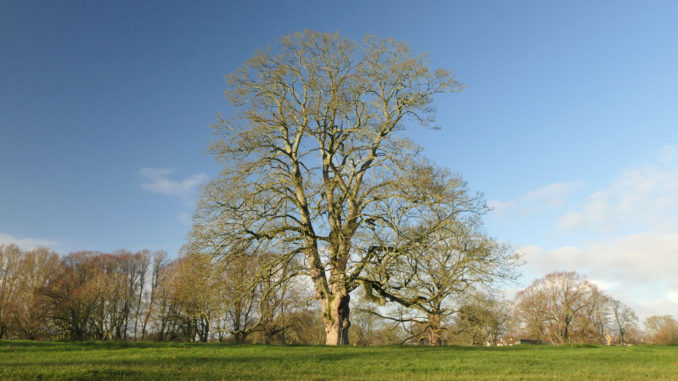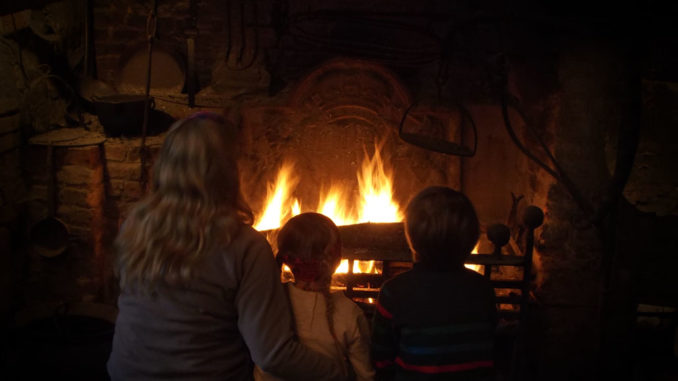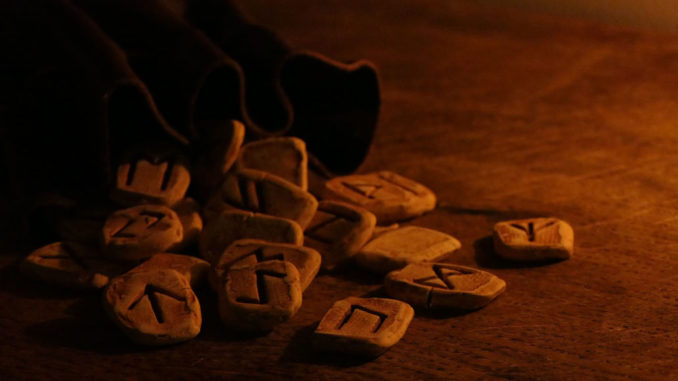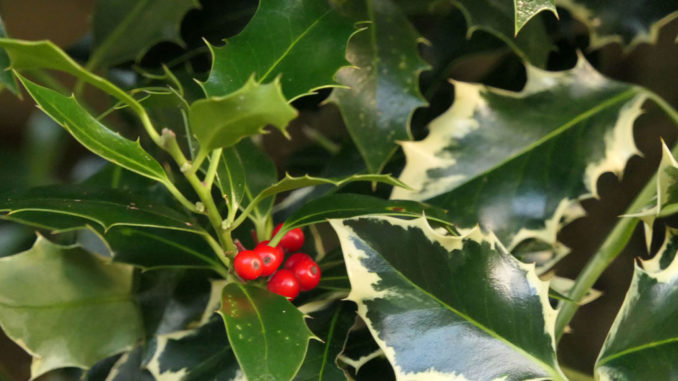
© DMG 2020
Yule
I grew up with Yule, even though I never really understood anything about it. It was just another word that was heard around Christmas time. People would wish each other a merry Yuletide, and there was as many greetings cards blessing you with Yuletide Wishes as there were Christmas cards. I really miss nice traditional Yule cards, as the only ones I see these days seem to have pentagrams and unicorns instead of nice wintry scenes with holly, mistletoe, or robins.
I vaguely remember asking as a child what Yule was, but I don’t remember ever receiving a particularly illuminating answer. So hopefully I can provide some of the answers I wished I’d had as a child.
Perhaps the most simplistic explanation people will have heard is that Yule is the solstice. Which it kind of is. But then again, it isn’t. The solstice is when Yule occurs, but it isn’t what it is.
The inhabitants of the British Isles were prolific henge builders. Our tribes in this rather wet and windswept part of the world have kept careful track of the seasons and the sun for thousands of years. I suspect that our rather dodgy climate was the key to this habit. We needed to make the most of the time when we could grow crops and raise cattle, and so had to be on the ball as to when it was safe to start tilling and planting, and when it was time to pack up and hunker down.
In a harsh and unforgiving world, knowing that you had survived to the turning point when you could expect to see more of the sun again must have been quite a relief, and no doubt a time of joy and hope. I particularly like how the Doctor (when played by Matt Smith) described it as “halfway out of the dark”.
And what better way is there to celebrate the rebirth of the sun than by having an almighty booze up around a big roaring fire. However, unlike the midsummer celebration, this was a time of quieter reflection.
So how long is Yule? The simple answer is ‘not just the day of the solstice’, because that’s when Yule begins.
Some used to celebrate it for three days. Far more common is a twelve-day celebration, starting on the solstice. Or thereabouts. Some flexibility seemed to be acceptable. One tradition says that the Yule feast was held on the first full-moon after the solstice.
A particularly appealing measure for the length of Yule was set by King Haakon I of Norway, who decreed that his people had to keep the holiday for as long as the ale lasted.
Central to the Norse customs was Odin leading the other gods on a 12-day hunt, which began on the solstice. They would battle wild boar, great elk, and a variety of other mythical beasts for twelve days and nights. Thor joined in, riding a wagon pulled by two goats, which is why the Yule goat is one of the oldest Yule motifs in Scandinavia. It was such a wild adventure that even the Gods got carried away in the excitement and were said to go a little bit mad.
Naturally, people would honour these twelve days by similarly getting carried away with feasting, sacrifice, drinking and dancing. The sacrifice part might sound a bit off-putting, but it just refers to appreciating the animals that were slaughtered. Commonly a boar featured, and much of the meat was boiled. This part of the feast is still firmly lodged in modern culture as a ‘Christmas ham’.

© DMG 2020
It was a time for community to come together. Ale and wine which had been fermenting was now ready for consumption, and toasts would be drunk for a multitude of reasons. They were drunk to Odin, to the other Gods, for the coming harvest, for fertility, for good health and a good life, for departed kinsfolk, and for peace and harmony. I can imagine revellers struggling to come up with novel ideas for toasts and feeling a little bit relieved when the wine and ale finally ran out.
Cementing the importance of a hearty feast is the fact that in many Old Norse poems, the word Yule is simply used as a synonym for ‘feast’.
This celebration is far older than the word Yule, which is reflected in the Old English ‘geol’ and the Old Norse ‘jól’. Some scholars who know about such things think they all stem from the Germanic ‘jehwla’, though no-one really knows for sure, and it’s also possible all these words have a common ancestor. Suffice to say, Yule is very old indeed. There is little doubt its origins are pre-Christian.
There was considerable sharing of culture between the Germanic tribes, the Norse, and the Celts. No doubt this ‘sharing of culture’ wasn’t always peaceful and the Norse left a deeper impression on the Celts than the Romans did, which is why Yule is ingrained in the Scots and Irish culture more than the Saxons.
Just to confuse the issue further, for over a thousand years now the words Yule and Christmas have pretty much been used interchangeably, and the season of Yule or Yuletide can refer to a very vague period that started when it was particularly noticeable that the darker nights were drawing in.
Folklore maintains that the coming year is taking shape and anything that happens during Yule influences and creates the coming year. By enjoying a great celebration, the year was off to a good start, with the belief that things would continue in the same vein. By eating and drinking to excess over Yule, folk were fulfilling their sacred duty to ensure a year of plenty.
With minds focused on creating the year to come, the time was also ripe for divination, and no doubt people turned to various methods of fortune telling to ponder issues they had about the future.

© DMG 2020
Reinforcing the divination aspect was the most important figure in the Yule tradition: Odin. He is the most prominent figure in Norse mythology, and in the Germanic tradition he’s known as Woden, giving rise to Woden’s Day, now Wednesday.
Top of his CV is ‘god of war and death’, but he is also the god of wisdom, poetry, magic and divination. He is the protector of heroes. But even better, he is likely associated with Yule because of his role in ritual drinking. And honestly, who doesn’t want what is essentially a God of Drinking Games? That’s arguably even cooler than having a day of the week named after you.
Sporting a long white beard and hair, Odin is often described as wearing blue-grey robes and carrying a spear. When he wants to travel without drawing attention to himself, he will wear a blue hat with a wide brim. He is the archetype of the wizard. Just think ‘Gandalf’ and you’re pretty much there.
Some claim that Odin is the original Father Christmas, which is understandable seeing as how he is called Jólfaðr (Yule Father) or Jólnir (the Yule One).
His steed is an eight-legged horse named Sleipnir, who will feed on any grain or straw left over in the harvested fields whilst out on the Yule Hunt. Children would leave a boot outside or beside their chimney filled with hay or other treats for Slepinir, and Odin would leave behind a reward of sweat treats or a small toy. This tradition continues to this day, though in some Germanic regions the boot was replaced by a stocking which was filled with gifts. And interestingly, Jól is also the root of our word ‘Jolly’.
So there are some similarities with Santa Claus—who leaves gifts for good and kind children, and has eight reindeer whom children leave a snack for. However, the real Santa is undoubtedly Saint Nicholas of Myra, later known by the Dutch settlers of the New World as Sinta Klaas.
It has also been noted that in Asgard, Odin’s realm, there is a land called Alfheim, home to the fair elves. But I think that’s really stretching any connection, and I have yet to come across anything to even hint that Odin had these elves employed in the toy-building business.

© DMG 2020
Sacred to the ancient British were evergreen plants such as holly. Because they retained their leaves and colour throughout the winter they were viewed as being special and are linked with eternal life.
Holly is also central to beliefs around the constant battle between the Oak King and the Holly King. The Oak King dies at Samhain but is reborn at Yule. Thus, the Holly King rules the land throughout the dark half of the year, which is why holly is inextricably linked with the winter months and Yuletide. Holly was brought indoors as a symbol of hope and to protect against evil.
The Holly King will eventually weaken and be overthrown by the Oak King, who rules the summer months. There is a constant ebb and flow between the two, which was recognised as an eternal battle, not between good and evil as many seem to think, but simply between light and dark.
The Holy King also represents transformation, who gives life to new possibilities, echoing the Norse beliefs about Yule being a time for divination and creating the future. At some point in the distant past these ideas gave birth to the notion of new year resolutions.
The colour scheme of Yule has naturally stayed with us as the festive colours. Green and red from holly, ivy and other evergreen plants. Red from holly berries, and white from either holly flowers, snow or mistletoe berries.
Boughs of evergreens were brought indoors during the Winter, but while it is often suggested that Christmas trees are ‘pagan’ in origin, but this isn’t the case. People who respected or worshipped nature would never dream of celebrating by finding a lovely tree and chopping it down.
In some parts of Scandinavia, a tree felled for the Yule log might have the top portion saved and decorated, but this doesn’t seem to have been a particularly widespread tradition. Without going off on too much of a tangent, Christmas trees are Christian in origin, and stem from the ‘Paradise Plays’ performed early in December, often on the 6th, which was Saint Nick’s birthday. The play in question was the one about Adam and Eve, and the tree was basically a stage prop. Somehow it caught on. So if you want a proper, authentic Christmas tree, decorate it with apples and hide a serpent in it.
The importance of the Yule log is tied in with fire being an integral part of Yule. It brought light and warmth in, and supposedly encouraged a good harvest, ostensibly by either encouraging the sun to return, or to chase away the darkness. Or maybe they were just cold and were fed up with the constant darkness. Sometimes I wonder if we attribute too much superstition to ancient customs.
It is said that a Yule log should burn for the twelve days, and that a piece of it must be saved to light the following year’s fire. This showed the understanding that the year turns like a wheel and will eventually come full circle.
It always struck me as a bit optimistic to keep a fire going for twelve days straight and have a piece of your original log left over at the end, but the original Yule fires were community bonfires, burning massive pieces of lumber, such as a log gathered from the land. Many years ago, a friend of mine helped fell a tree, and the remaining piece of trunk with roots was dragged a short distance and dumped on the village bonfire. The bonfire had to be held in the exact same place for years afterwards because it stubbornly resisted burning away.
Inevitably, over time Yule moved indoors and became a household celebration and it was said that the Yule log should burn throughout the night of the solstice, then smoulder for the twelve days. At some point in history, someone decided that it was a good idea to douse it with flour and cider and decorate it with some seasonal greenery. I have no idea why. But there is probably more logic to that habit than there is in us scoffing chocolate rolls with a bit of plastic holly and a candle stuck in it. I dread to think what Odin makes of it all.
Growing up, it was clear to me that for Scots, New Year was a of greater importance than Christmas. While the Norse marked the New Year on the Solstice, it seems fitting that the Yule celebrations would climax sometime after the solstice, roughly when we now celebrate New Year. I remember my parent’s house being full of friends and neighbours, talking, laughing and drinking from when Auld Lang Syne was sung, and long past the wee hours. My mum would occasionally ferry pots of stovies or soup through from the kitchen, and even as a nipper, I was included and (mostly) awake until sunrise. It was a bit of a culture shock to say the least when I first celebrated New Year with an English family. We listened to the bongs of Big Ben, shook hands, then they went off to bed. I think it took me longer to recover from that New Year than any which involved alcohol.
So as you can see there is much more to Yule than ‘the solstice’. It is a time to celebrate surviving the descent into darkness, and a time to start creating the future. But it is also a time of excessive eating and drinking to honour of the wizard god of drinking games. Yep. Works for me.
No wonder I never got a straight answer as a child…
Gifts don’t need
To be extravagant
A little praise is often enough
Sharing food
And something to drink
Has secured many friendships
HÁVAMÁL – verse 52
So, eat, drink and be merry, and don’t forget to start making plans for the coming year. All being well, things should be showing signs of progress at the start of February, just in time for Imbolc.
© Carvetii 2020
The Goodnight Vienna Audio file
Audio Player



